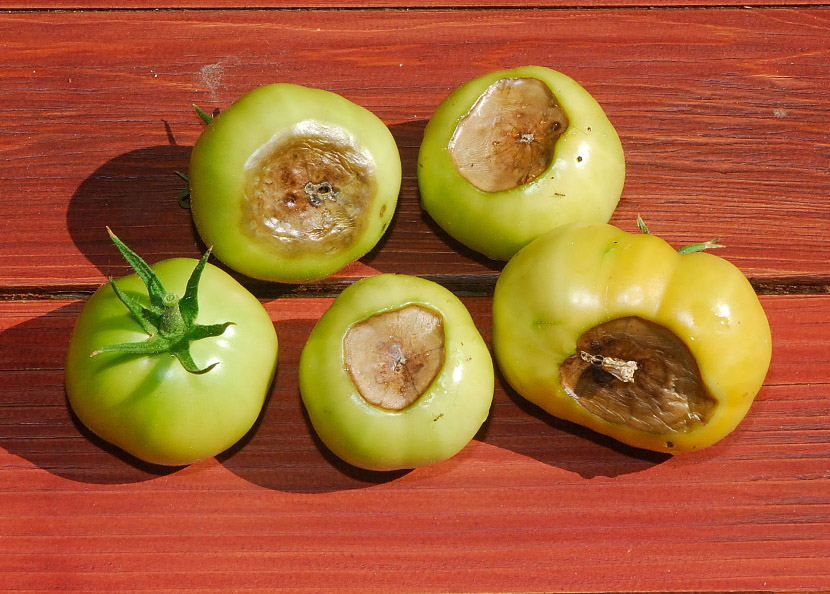While the vegetable garden area is being prepped this year, we’ve been growing our tomatoes in pots on our front deck. As there is a railing around this deck, it is one of the few places here where our plants are safe from browsing deer, at least until the deer fence is installed.
We use generous sized pots for the plants, and each pot is connected to our drip irrigation system. Weather-wise, this year has been a bit troublesome for our tomatoes. For much of summer we’ve had below average temperatures, and our ‘June gloom’ summer fog started before June this year, persisting well through summer, and has contributed to increased humidity, and cooler mornings. This alone seems to have caused our tomato season to get off to a slow start, and some friends and neighbors also report a lagging tomato harvest this year.
In addition to the abundance of cool weather, we’ve also had some randomly interspersed periods of excessive heat, with temperatures in excess of 105F some days. Last weekend in particular was miserably hot, and despite our best efforts our tomato plants spent a few days in a somewhat persistently wilted state. This was quite problematic for our larger heirloom varieties like ‘Radiator Charlie’s Mortgage Lifter’ and ‘Marvel Stripe’, both of which suffered snapped stems secondary to large fruit size coupled with excessive wilting of the plants in the heat. Most of the stems however were saved with some additional supports, and the fruit on those varieties continues to mature and ripen.
Sadly however, one variety in particular has not faired as well with the temperature extremes this season. ‘Big Orange’ has suffered a complete and total crop failure for 2009. Although the plant itself is lush, green, and healthy, and the fruit seemed to be maturing well, on closer inspection we found that this last wave of hot weather took a heavy toll on the ‘Big Orange’ fruit. As seen in the photographs below, our entire crop of ‘Big Orange’ has been lost to the dreaded Blossom End Rot.
This is not a bacterial, viral, parasitic, or fungal disease, and as such, ‘Big Orange’ seems to be the only variety we’re growing this year that has been affected. Blossom End Rot is a physiological disorder of the plant, not uncommon in tomatoes, and can also occur in peppers, eggplants and melons. The characteristic lesions begin as a dark softened spot at the blossom end of the fruit, and may be an indication that the plant has endured environmental stresses that have interfered with water and calcium uptake. The plant is otherwise healthy, and if this had occurred earlier in the season, and the conditions that triggered this problem were corrected, a second, healthy crop of tomatoes could potentially be produced from the same plants.
Some varieties of tomato are reportedly more prone to this disorder than others, and of the varieties we are growing this year, ‘Big Orange’ seems to have been the most prone. Many factors can contribute to the development of this disorder, including drought, root damage secondary to cultivation, excess salts in the soil, low soil calcium, or heavy soils (impeding root development and affecting nutrient uptake). Blossom End Rot is also commonly observed in young plants that have yet to establish an extensive enough root system to support the developing fruits. In such cases, simple removal of the early affected fruit is sufficient to control the problem, as the later fruit will be produced after the plant’s root system has matured. In the case of ‘Big Orange’, we expect that the recent period of excessive heat, coupled with the confinement of the roots in pots, that are themselves prone to rapid drying-out, predisposed our crop to Blossom End Rot this season.
Despite this unfortunate loss, we still have many other varieties of tomatoes producing significant quantities of fruit waiting to be enjoyed in our salads, sandwiches, and pizzas, for the remainder of the summer season. Next year all of our tomatoes will be planted out in raised beds in the garden, providing us with more control over the growing conditions, and hopefully reducing the likelihood that Blossom End Rot will rear its ugly head again.








